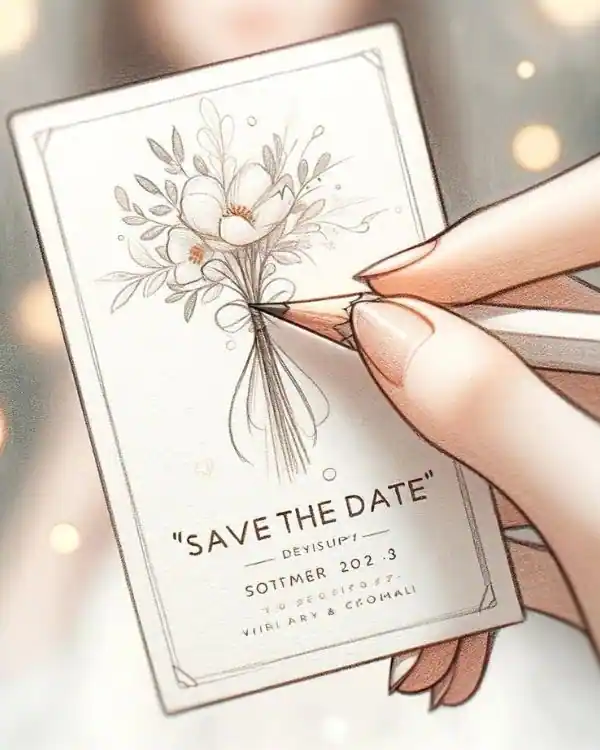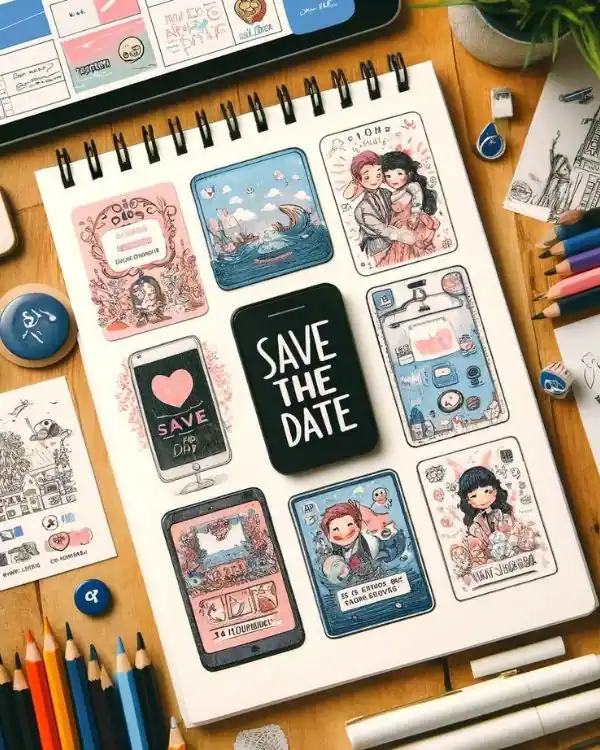Advertisement
By IS Team
What Does 'Save the Date' Mean? Unpacking The Essentials For Your Big Event

Advertisement
"Save the date" is more than a preliminary notice—it's a crucial first touchpoint that marks the beginning of your event's journey. At its essence, 'Save the Date' sets the emotional and logistical foundation for an upcoming event, ensuring that your special day is reserved in your guests' busy lives well in advance.
It's an invitation to anticipate, prepare, and participate in a forthcoming celebration, creating a buzz and building excitement. By sending out these notices, you communicate the importance of each guest's presence, transforming your event into a highlighted date in their calendars.
'Save the Date' acts as a beacon, guiding your guests to the event while allowing them ample time to arrange their schedules—making it more than a reminder, it's a prelude to the celebration.
The Basics of 'Save the Date'

What Exactly Is a 'Save the Date'?
A 'Save the Date' is much more than a preliminary announcement—it's the spark that ignites excitement among your guests about your upcoming event. This prelude to the formal invitation serves a simple yet vital purpose: to ensure that your guests reserve your special day in their bustling schedules well in advance. 📆 It's your first chance to whisper the news of the big event, be it a wedding, anniversary celebration, or a grand corporate gala.
Purpose of 'Save the Date' Notices
The primary goal of a 'Save the Date' is clear and concise: "Mark your calendar. Something wonderful is on the horizon." By sending out these notices, you're not only giving your guests a heads-up but also expressing the importance of their presence at your event. It's about creating a buzz and ensuring that your guests are as excited as you are about the upcoming celebration.
'Save the Date' vs. Formal Invitations: Understanding the Distinction
While both 'Save the Date' and formal invitations are integral to your event's communication strategy, they serve distinctly different purposes and set different tones:
- 'Save the Date' Notices: These are sent well in advance and are typically brief. They focus solely on the date and the event type, ensuring guests know the when and what at the earliest opportunity. They are teasers, devoid of the finer details, designed to pique interest and ensure availability.
- Formal Invitations: These are the main events of your event communication, sent closer to the actual date. They include all the essential details: the exact time, venue, dress code, RSVP instructions, and often a hint of the event’s theme or style. This is where you invite guests to become participants in your celebration, providing them with all they need to attend and enjoy the occasion.
By understanding and utilizing the unique roles of 'Save the Date' notices and formal invitations, you ensure a smooth communication flow and maximize anticipation and attendance. Think of 'Save the Date' as the exciting trailer for your event's blockbuster movie—the formal invitation is the feature presentation! 🎥✨
Why 'Save the Date' Is Crucial
Securing Attendance in Busy Schedules
- Prioritize Your Event: Ensures your event gets marked on busy calendars well in advance.
- Avoid Conflicts: Reduces the risk of guests having conflicting commitments.
Setting the Tone and Building Anticipation
- First Impression: Acts as a teaser that sets the emotional and thematic tone for your event.
- Stir Excitement: Begins the build-up of excitement, making the event a highly anticipated one.
- Invitation to Prepare: Especially important for destination events, allowing guests ample time to arrange travel and accommodations.
These points underscore the practical and emotional significance of 'Save the Date' notices, making them a pivotal part of event planning.
Ideal Timing for Sending Out 'Save the Date' Notices

Timing can make or break the effectiveness of your 'Save the Date' notices. Here's how to get it just right:
Recommended Lead Times for Different Events:
- Weddings: Typically sent 6 to 12 months in advance. If you’re planning a destination wedding, lean towards the 12-month mark to give guests more time to plan travel.
- Corporate Events: For large conferences or seminars, aim for 4 to 6 months ahead. This window allows professionals to schedule around work commitments.
- Casual Gatherings: Family reunions or birthday parties can have a shorter lead time of 3 to 4 months, depending on the scale and the travel involved for guests.
Factors Influencing When to Send Them Out:
- Guests’ Location: If many guests are coming from out of town or overseas, more notice is better to arrange travel and accommodation.
- Event Size and Scale: Larger, more elaborate events require more notice than smaller or more informal gatherings.
- Time of the Year: Consider peak holiday seasons or busy times that might affect guests' availability. Events near major holidays or during vacation seasons should have notices sent out earlier.
By carefully considering these factors, you can choose the optimal time to send out your 'Save the Date' notices, ensuring maximum attendance and excitement for your event. Remember, the key is to give your guests enough time to plan, without sending them so early that the event is forgotten. Plan wisely and watch the anticipation for your event build beautifully! 📅✨
Essential Information to Include in 'Save the Date' Notices
When crafting your 'Save the Date' notices, striking the right balance of informativeness and simplicity is key. Here’s what to include to ensure your guests have all they need to begin their preparations:
1. Date and Location of the Event
- Date: Clearly state the day and date of the event. If it spans multiple days, include the range (e.g., "July 20-22").
- Location: Provide the city and, if applicable, the specific venue. This helps guests gauge travel logistics.
2. Notice of a Forthcoming Formal Invitation
- Communicate that this is just the first notice. A formal invitation will follow with more details. This sets expectations and keeps the anticipation alive.
3. Travel and Accommodation Information for Destination Events
- Travel Tips: If it’s a destination event, suggest routes or preferred airlines if you have partnerships or recommendations.
- Accommodation Options: Include suggested hotels or accommodations, especially if you have arranged for group rates or blocks.
- Additional Details: Consider adding a link to your event’s website or contact for more immediate inquiries, where guests can find ongoing updates about the event.
Including these essential pieces of information will not only enhance your guests' experience by making their planning process smoother but also demonstrate your thoughtfulness as a host. This attention to detail can turn a simple notice into a useful and appreciated gesture, paving the way for a successful and memorable event.
Creative Formats and Ideas for 'Save the Date'
Choosing the right format and infusing creativity into your 'Save the Date' notices can make a significant impact on how your event is perceived right from the start. Here are some inventive ideas and formats to consider:
Innovative Design Ideas

- Interactive Designs: For digital 'Save the Dates', include interactive elements like a mini-game themed around the event, or a quiz about the couple for a wedding.
- Thematic Designs: Align the design with the theme of your event. For a beach wedding, think of ocean colors and sand texture effects; for a tech conference, sleek, modern designs with interactive tech elements like QR codes.
Examples of Catchy and Effective 'Save the Date' Messages
- For Weddings: "Mark Your Calendars! [Name] and [Name] are tying the knot! 💌 Save the Date for [Date] in [Location]. Formal invitation to follow."
- For Corporate Events: "Get Ready to Innovate! Join us for [Event Name] on [Date] at [Location]. Watch your inbox – more details are coming soon!"
- For Casual Gatherings: "Pack your party hats! [Name]'s 40th Birthday Bash is on [Date]! Save the date and stay tuned for more fun details!"
By blending creativity with practicality, your 'Save the Date' can go beyond a simple announcement—it can be an engaging, memorable first impression that builds excitement and anticipation for your big event.
Explore Our Digital Invitation Designs
For a closer look at how we can transform your 'Save the Date' into an enchanting prelude to your event, visit our digital invitation site. Discover our full range of creative, customizable designs that promise to make every 'Save the Date' as unique and special as your upcoming event.
Common Mistakes to Avoid in 'Save the Date' Notices
When crafting your 'Save the Date' notices, navigating around some common pitfalls that can diminish their effectiveness is crucial. Here’s how to avoid these missteps and ensure your notice accomplishes its purpose perfectly:
1. Overloading with Too Much Information
- Keep It Simple: The goal of a 'Save the Date' is to inform and intrigue, not to overwhelm. Stick to the essentials—date, location, and a hint of what's to come. Save the detailed itinerary and additional information for the formal invitation.
2. Sending Them Out Too Early or Too Late
- Timing is Key: Sending your notices too early can lead to them being forgotten while sending them too late might not give your guests enough time to arrange their schedules. Aim for the sweet spot recommended for each type of event, adjusting based on factors like location and event size.
3. Neglecting to Match the Style and Theme of the Main Event
- Consistency Matters: Your 'Save the Date' should be a teaser of the main event's style and theme. A mismatch can confuse guests or set the wrong expectations. Ensure that the design and tone of your 'Save the Date' align with the overall aesthetic and vibe you are planning for the event.
By steering clear of these common errors, you can enhance the impact of your 'Save the Date' notices, setting the stage for an event that feels thoughtful and well-organized right from the start.
Integrating 'Save the Date' with Overall Event Branding

Creating a cohesive event experience starts with your 'Save the Date' notices. These initial announcements are not just logistical tools; they are integral to your event branding. Here's how to ensure they effectively integrate with and enhance your overall event branding:
Consistency in Design and Messaging
- Visual Harmony: Ensure the design elements of your 'Save the Date'—from color schemes and fonts to imagery and logos—align with the branding of your event. This visual consistency helps in reinforcing brand identity and enhances recognition.
- Tone and Voice: The messaging should reflect the tone of your event. Whether it's formal, playful, or innovative, the language used in your 'Save the Date' should match the voice that will characterize your event communications.
How 'Save the Date' Sets the Stage for Event Branding
- First Brand Touchpoint: Your 'Save the Date' is often the first encounter guests have with your event's brand. It sets expectations and starts the narrative, making it a foundational piece of your event's story.
- Building Anticipation and Engagement: Well-branded 'Save the Date' notices do more than inform—they excite and engage. By integrating thematic elements and branding, you turn a simple announcement into a compelling preview of what guests can expect.
Effectively integrating your 'Save the Date' with your event branding not only ensures a seamless aesthetic experience but also builds a stronger connection with your guests. This strategic alignment enhances the overall impact of your event communications and paves the way for a memorable experience.
Frequently Asked Questions
1. Can I send 'Save the Date' notices for events other than weddings?
Absolutely! 'Save the Date' notices are beneficial for any significant event requiring planning, including milestone birthdays, anniversaries, and corporate events.
2. Should 'Save the Date' cards match the wedding invitations?
While not mandatory, having 'Save the Date' cards that reflect the style and theme of your wedding invitations helps maintain consistency and sets a cohesive tone for your event.
3. Is it appropriate to include a registry information on a 'Save the Date'?
It's generally best to leave registry information off of 'Save the Date' notices and save it for formal invitations or wedding websites to keep the focus on informing about the date.
4. What do I do if my event details change after sending out 'Save the Date' notices?
If major details like the date or location change, it’s important to communicate these changes to your guests as soon as possible. A follow-up message or card correcting the information can help manage expectations and keep your guests informed.
Advertisement
I'm Looking For!








